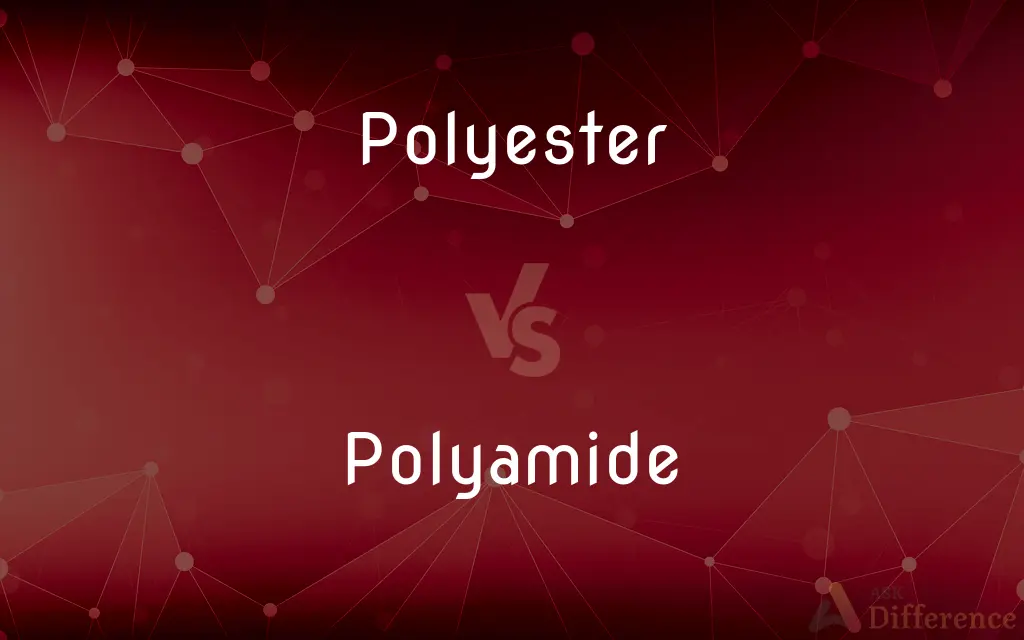Polyester vs. Polyamide — What's the Difference?
Edited by Tayyaba Rehman — By Fiza Rafique — Updated on September 26, 2023
Polyester is a synthetic polymer made from ester monomers, known for its durability, wrinkle resistance, and moisture-wicking properties. Polyamide is synthetic polymer with amide linkages in the molecular structure, known for its strength, flexibility.

Difference Between Polyester and Polyamide
Table of Contents
ADVERTISEMENT
Key Differences
Polyester: Composed of ester functional groups in its polymer chain. Polyamide: Contains amide functional groups (CONH) in its polymer chain.
Polyester: Known for its resistance to wrinkles, moisture-wicking properties, and durability. Polyamide: Recognized for its strength, flexibility, and abrasion resistance.
Polyester: Generally more affordable and widely available in various forms. Polyamide: May be relatively more expensive and commonly used in specialized applications.
Compare with Definitions
Polyester
A versatile material used in carpets, praised for its stain resistance.
Polyamide
A flexible material used in climbing ropes for its durability.
ADVERTISEMENT
Polyester
A type of plastic polymer used in PET bottles for beverages.
Polyamide
A strong synthetic polymer used in making nylon stockings.
Polyester
A durable fabric used in outdoor cushions, known for its weather-resistant properties.
Polyamide
A fabric known for its moisture-wicking properties, ideal for sportswear.
Polyester
A synthetic fiber used in packaging materials due to its strength.
Polyamide
A versatile engineering plastic employed in manufacturing gears for machinery.
Polyester
Polyester is a category of polymers that contain the ester functional group in every repeat unit of their main chain. As a specific material, it most commonly refers to a type called polyethylene terephthalate (PET).
Polyamide
A type of plastic used in automotive parts for its heat resistance.
Polyester
A synthetic resin in which the polymer units are linked by ester groups, used chiefly to make synthetic textile fibres.
Polyamide
A polyamide is a polymer with repeating units linked by amide bonds.Polyamides occur both naturally and artificially. Examples of naturally occurring polyamides are proteins, such as wool and silk.
Polyester
Any of numerous synthetic polymers produced chiefly by reaction of dicarboxylic acids with dihydric alcohols and used primarily as light, strong, weather-resistant resins in boat hulls, textile fibers, adhesives, and molded parts.
Polyamide
A synthetic polymer of a type made by the linkage of an amino group of one molecule and a carboxylic acid group of another, including many synthetic fibres such as nylon.
Polyester
A wrinkle-resistant fabric of fibers made from any of these resins.
Polyamide
A polymer containing repeated amide groups, as in various kinds of nylon.
Polyester
Any polymer whose monomers are linked together by ester bonds
Polyamide
(chemistry) Any of a range of polymers containing amide (or peptide) repeat units; examples include proteins and nylon.
Polyester
A material or fabric made from polyester polymer
Polyamide
A polymer containing repeated amide groups
Polyester
Of, or consisting of polyesters
Polyester
Any of numerous synthetic resins; they are light and strong and weather resistant
Polyester
A complex ester used for making fibers or resins or plastics or as a plasticizer
Polyester
Any of a large class of synthetic fabrics
Polyester
A synthetic polymer known for its wrinkle resistance, often used in clothing like polyester shirts.
Common Curiosities
What is polyester made from?
Polyester is made from ester monomers, usually derived from petroleum-based chemicals.
Can polyester fabrics be ironed?
Yes, polyester fabrics can be ironed at low to medium temperatures to remove wrinkles.
What is the primary characteristic of polyamide (nylon) fabrics?
Polyamide fabrics, such as nylon, are known for their strength, flexibility, and resistance to abrasion.
What are some common applications of polyamide engineering plastics?
Polyamide engineering plastics are used in automotive parts, gears, and industrial components due to their durability and heat resistance.
Is polyester environmentally friendly?
While polyester can be recycled, it is not considered as eco-friendly as natural fibers like cotton.
Can polyamide materials be recycled?
Some types of polyamide, especially nylon, can be recycled into new products.
What are the advantages of using polyester in clothing?
Polyester offers wrinkle resistance, moisture-wicking properties, and durability, making it suitable for sportswear and everyday clothing.
Is polyamide fabric suitable for outdoor activities?
Yes, polyamide fabrics like nylon are commonly used in outdoor clothing and gear because of their toughness and moisture-wicking properties.
What is PET, and how is it related to polyester?
PET (polyethylene terephthalate) is a type of polyester often used in the production of plastic bottles for beverages.
What is the difference between polyamide and polyester in terms of feel and texture?
Polyamide fabrics like nylon tend to have a smoother and softer feel compared to the often sleek and shiny texture of polyester.
Share Your Discovery

Previous Comparison
Through vs. Thorough
Next Comparison
Beforementioned vs. AforecitedAuthor Spotlight
Written by
Fiza RafiqueFiza Rafique is a skilled content writer at AskDifference.com, where she meticulously refines and enhances written pieces. Drawing from her vast editorial expertise, Fiza ensures clarity, accuracy, and precision in every article. Passionate about language, she continually seeks to elevate the quality of content for readers worldwide.
Edited by
Tayyaba RehmanTayyaba Rehman is a distinguished writer, currently serving as a primary contributor to askdifference.com. As a researcher in semantics and etymology, Tayyaba's passion for the complexity of languages and their distinctions has found a perfect home on the platform. Tayyaba delves into the intricacies of language, distinguishing between commonly confused words and phrases, thereby providing clarity for readers worldwide.















































